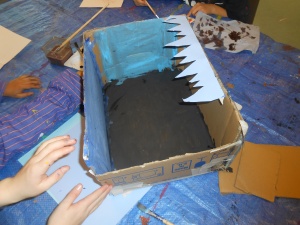This is now my fourth year teaching in Year 3, in the same school. This has certain beneficial effects: not having to move classroom is probably the most prominent among them. Another benefit is that, even though I change a few things every year (if only to prevent my own boredom), I pretty much know what I’m doing. Minor tweaks here and there for the benefit of each class, but there are also other areas that don’t require much tweaking that I can more or less teach with my eyes closed, as it were. I’ve also gotten to know the pastoral side of Year 3 quite well – that transition from baby infants to big juniors, that some find easier than others. Getting the ratio of TLC to tough love just about right.
Why yes, there is a massive ‘however’ coming up. How did you guess?
However. This year’s class are Different. It pains me greatly to admit that they have a Reputation. I wish they didn’t. I wish they could be seen neutrally, as the beautifully hardworking students they very often are. But equally, I can’t pretend they haven’t been tricky, and they haven’t stood out, since they joined us in Nursery, then as one whole class in Reception. They’re boisterous, full of Personalities, who very often clash with one another. There are too many children who have to be right, who have to win, who lack the vital skills of give and take. This makes them, to put it mildly, a challenge to manage.
Before I go any further, something vital: I love my class. They’re mine, and while I’m (necessarily) tough with them, I’ll defend them till I’m blue in the face when warranted. They’re awesomely hard working, and rise to almost any academic challenge you throw at them. So if a lot of what follows sounds excessively negative, remember: I love them.
They’ve always found playground life hard – 15 minutes of break is just about enough, and often by the end of that tempers are fraying and someone’s either on the wall, or in tears, or missing their next playtime due to violent behaviour, or all three. In the classroom as well, they’re difficult to settle, and just silly. They have that terrible habit of feeding off each other – so someone says something silly (often about bottoms, or farts, or boobies), it’s whipped round half a dozen people before you’ve even noticed it starting and you’ve effectively lost 5 minutes of lesson.
As a result of all of this, it very quickly became clear in September that things – things meaning my practice – would have to change to accommodate this class. What has followed has been my most challenging year as a teacher so far. I’ve had to re-evaluate almost everything I do in the classroom, and I’ve had to continue to monitor myself and reflect on my teaching in a way that has probably been the making of me, but which has also been incredibly hard work.
So, time to get specific: what have I been doing differently?
The first major change was in seating arrangements. Typically in Y3 I still make a lot of use of the carpet area, at least for the first 2 terms. It gradually gets used less and less in the summer, but is still there if we need to gather in a circle etc. My current class, it quickly became apparent, can’t really cope with a carpet area. Settling them was a nightmare, no matter how many seating arrangements we tried. So now, we don’t use the carpet space, ever. Instead, the tables are in rows, with a central aisle, and each child has their own place – which they generally don’t move from, whatever the subject. I do re-jig the seating from time to time, and it’s never quite perfect, but they value the consistency of having their own space. That consistency is vital for this class.
Secondly, play times. More specifically, the end thereof. I don’t do lining up – I think it wastes time. However, this class need that very clear transition from break to work time. So, we line up. Once we’re all silent, I let the kids in half a dozen or so at a time, to go and sit quietly at their tables – there’s often a starter task out. I stand very deliberately at the door, greeting everyone, so as to establish that they’re now back in my space. No-one’s allowed in until children already in the room are settled, which allows for a gradual building up of a good working atmosphere.
Thirdly, instructions. I give instructions one at a time, always standing in the same place (front and centre). Every instruction starts “Year 3…”, and is given twice. Then I wait until it’s been followed, by everyone. So it might be “Year 3, books closed please [pause, 5 or 10 secs] I said, Year 3, books closed please.” Then wait. Thumbs up and a quiet well done to those who get there quickly, TAs mop up the few who are ignoring, then once everyone has closed their book, I carry on. It can be awe-inspiringly tedious, but again, it works for this class. They need to know that when I give an instruction, I expect it to be followed by everyone, every time. There’s no wiggle room. Again, consistency is king.
Fourthly, lesson style. These guys need to be busy. More busy = less trouble. They also do much better with a clear structure. ‘Draw a picture about this story and write 5 sentences to go with it’ will get you nowhere except hassle and bad behaviour. This has meant a big change for me as I tend to favour more open ended activities that give kids room to express themselves. I had also been experimenting more in the past couple of years with letting the kids lead the learning, taking lessons where they wanted to go. As you may have gathered, if you give this class an inch, they’ll have run a mile before you can blink. So it’s all very much teacher led, chalk and talk, demo and do. I think this has improved my teaching in many respects – I’ve had to think much more carefully about what I want from the class, in order to be able to communicate that clearly to them. This is a Good Thing, in that it focusses me more. It’s also meant more modelling, which as I seem to discover anew every time I do it, works wonders.
There’s so much more I could say: the minutiae of managing certain individuals, including helping the class not to get too stressed at endless door slams (tip: mark them out of 10); working hard to ensure positive relationships with all the children in the class; keeping parents reassured when they (understandably) worry about their children’s progress in such a tricky class. However, the points detailed above cover most of the bases.
To finish: when I was buried in the depths of frustration early in September, not understanding at all why these kids wouldn’t just be like Year 3s should be, a friend said something to me that has more or less become my guiding star this year:
You have to teach the class you have, not the one you wish you had.
Amen to that.





Recent Comments